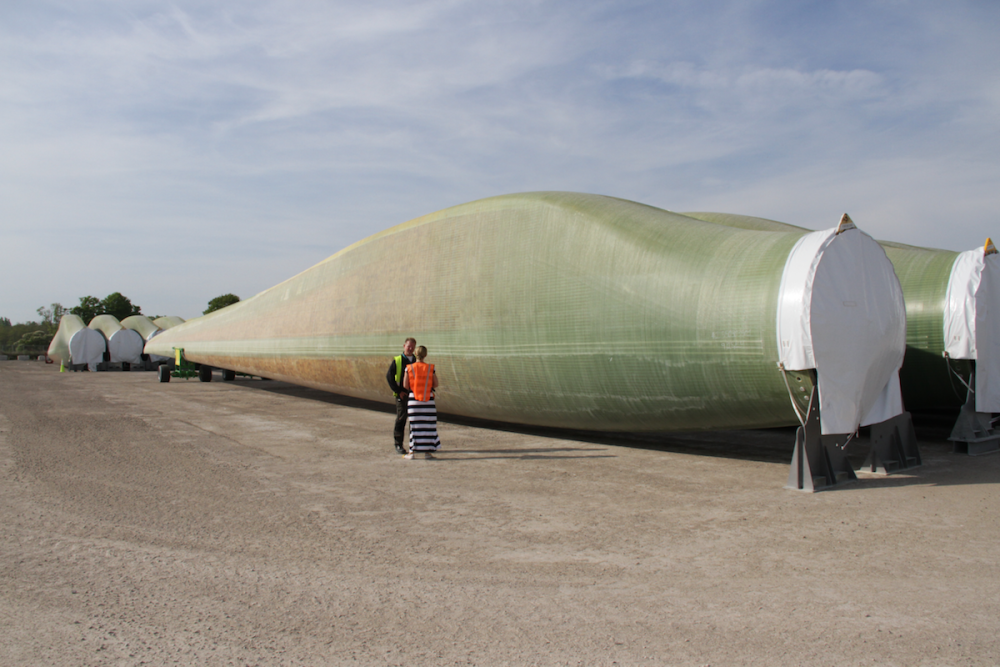The story of Tillsonburg is probably close to the ideal example of what the Ontario government was looking for when it enacted the Green Energy Act in 2009.
A small town of 16,000 people in southwestern Ontario, Tillsonburg’s history is famously celebrated in Stomping Tom Connor’s distinctive drawl when he sung about making seven dollars a day in the tobacco fields. Eventually tobacco gave way to the auto parts manufacturing industry, but that too didn’t last. Unemployment and shuttered factories followed the decline of that industry in the 1990s and 2000s.
Then in 2009 the Green Energy Act spurred on the development of renewable energy with guaranteed rates for renewable energy producers, as well as a controversial local manufacturing provision that was eventually overturned by the World Trade Organization.
It wasn’t controversial to the people of Tillsonburg. The German conglomerate Siemens started eyeing the town as a possible location to manufacture wind turbine blades. In December of 2010 they announced the project and were quickly swamped with applicants.
“Thinking back to when we had a job fair, I think in March of 2011. There was an unbelievable amount of people who were applying for a very limited amount of positions,” says Greg Thrasher, a manager of sales and strategy for wind power for Siemens Canada.
They refurbished a mothballed auto parts plant that was large enough to handle the giant blades. The location also made sense because of its connection to roads, railways and the seaway. It was also conveniently located close to much of the wind development in southwestern Ontario.
 With the local manufacturing provision gone Siemens is looking to the future.
With the local manufacturing provision gone Siemens is looking to the future.
“We never anticipated the Green Energy Act was going to be around forever,” says Thrasher. “So when we set out, we did so with the idea of diversification in mind and diversifying our presence outside of Ontario — in doing things like addressing the Alberta market, the Saskatchewan market and taking a focused approach to the Quebec market.”
This factory has joined the global supply chain. Last year they sent their first order of blades to Sweden and they’ll soon be sending blades to Quebec. Mostly, though, they’re still backfilling orders for projects in Ontario.
Jobs, jobs, jobs
 The plant makes 49-metre and 55-metre blades and they turn out approximately 18 per week. In February of 2015 they built their 1,000th blade.
The plant makes 49-metre and 55-metre blades and they turn out approximately 18 per week. In February of 2015 they built their 1,000th blade.
“It's a clean industry. It's an industry that represents the future of good solid jobs in the province of Ontario,” says Stephen Molnar, the mayor of Tillsonburg. The factory employs over 400 people and is the biggest employer in the town.
“And that's not just people from our urban center here, but throughout this entire Tri-County region where people are being displaced off of their farms because of other policies and the pressures that are being brought to bear on the family farm,” says Molnar.
Wind power isn’t new to plant manager Niels Kelter-Wessenberg who brings an unflappable sense of stoic Danishness to the proceedings.
“Where I come from in Denmark, we've had wind power for the last 50 years. It's just a normal part of the way we think with renewable energy,” says Kelter-Wessenberg. “When I'm back in my garden at home, no matter where I look, I see a spinning turbine. So to me, it's not something that's extraordinary.”
But don’t get him wrong; it’s a pretty cool job. It’s a mix of high tech manufacturing, huge mold making and autobody work.
They lay out 55-metre long giant molds and fill them with precisely cut layers of woven fiberglass. A pre-made foam mandrel supports a light wooden frame. They put a bottom and a top lid on, and then inject the resin. Once it’s dry, imperfections are sanded or filled, and then it’s sent to an “oven” to cure. Then the blade is painted white, weighed and shipped out.
Next to the behemoth blades, the workers look like ants. Three blades are shipped in sets and require a police escort on the road. Put two 55-metre blades end-to-end and it’s the length of a CFL football field. Each one weights about 12 tonnes despite being hollow.
According to a market analysis commissioned by the government of Ontario, wind energy manufacturing employs as many as 3,500 people in Ontario. The report says this number could drop to 2,000 in slower years. However, blades are specific to each turbine manufacturer so they can’t contract them out to third parties.
Each blade is an incredible piece of aerodynamic technology. As Kevin Standish of Siemens explains in this excellent video, the blades must withstand tremendous stress. Every second, 100,000 kilograms worth of air passes through one of these turbines. The blades have to be able to stand up to that for 20 years.
Siemens makes 49-metre blades for a conventional 2.3-megawatt wind turbine and 55-metre blades for a 3-megawatt gearless turbine. The towers are about 100 metres tall and the finished turbine weighs more than 200 tonnes.
“It’s an exciting industry: our customers are great and we get to play with big pieces of Lego that spin, it’s great.” says Thrasher.










